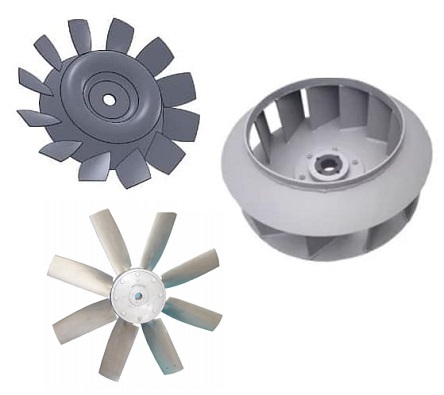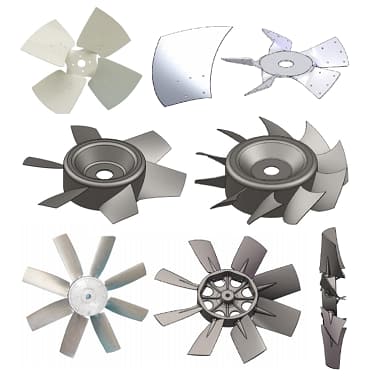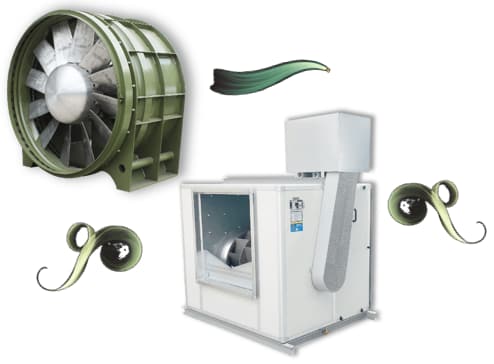Brief Intro of Mixed Flow Fan
In industrial and commercial ventilation systems, mixed flow fans have emerged as an efficient solution bridging the gap between axial and centrifugal technologies. Their unique structural configuration enables them to combine high airflow with moderate pressure capability and relatively low noise, making them especially suitable for tunnel ventilation, underground garages, commercial buildings, and HVAC systems.
At Zhejiang Shuangyang Fans Holding Co., Ltd, we offer a range of mixed flow fans, including open impeller models, units with inlet/outlet silencers, and fully enclosed cabinet-style designs.
What is a Mixed Flow Fan?
A mixed flow fan, also known as an axial-centrifugal fan, directs air at an angle between the axial and radial directions. Unlike axial fans (which move air parallel to the shaft) or centrifugal fans (which move air at 90°), mixed flow fans generate a spiral airflow path, resulting in higher pressure generation than axial fans while maintaining a compact footprint compared to centrifugal fans.
Impeller Design: The Hybrid Core
The impeller is the heart of a mixed flow fan. It features curved blades mounted on a conical hub, strategically shaped to accelerate air both axially and radially. The design combines:
-
Axial flow blade aerodynamics, for higher airflow rates
-
Radial deflection, for improved pressure buildup
-
Tapered hub geometry, for reducing turbulence and backpressure
Blade materials vary depending on the application, ranging from aluminum alloy (lightweight, corrosion-resistant), to galvanized steel, stainless steel, or composite resins for harsh or corrosive environments.
Some industrial models employ bolted adjustable-pitch blades to fine-tune performance according to site requirements.
Casing and Diffuser Section
The fan casing plays a critical role in containing the airflow and reducing noise. Typical structural features include:
-
Shell: Surrounds the impeller (cabinet-type mixed flow fan integrated acoustic insulation)
-
Aerodynamic inlet cone: Ensures smooth entry of air into the impeller, reducing turbulence
-
Conical diffuser: Positioned after the impeller to recover static pressure and control air velocity at the discharge
The casing can be fabricated from powder-coated steel, stainless steel, or aluminum, depending on installation location and environmental factors.
Models such as those from SHUANGYANG FAN include sound-attenuating liners within the housing to meet low-noise requirements for residential buildings or hospitals.
Drive System and Motor Configuration
Mixed flow fans can be configured with either:
Direct-drive:
The impeller is mounted directly on the motor shaft. This offers compact design, minimal maintenance, and high efficiency.
Belt-drive:
Enables flexible speed control but requires more space and periodic belt maintenance.
High-efficiency EC (Electronically Commutated) motors or VFD-compatible motors are increasingly used to reduce energy consumption and allow variable speed operation.
Integrated Silencers and Enclosures
In noise-sensitive environments, mixed flow fans are often equipped with inlet and outlet silencers or built as enclosed cabinet fans. These structural features may include:
-
Internal sound-absorbing foam
-
Perforated metal baffles
-
Modular inlet/outlet silencers
This structure helps ensure compliance with local noise regulations and enhances thermal and acoustic performance without requiring external mufflers.
Mounting and Vibration Isolation
Depending on the application, mixed flow fans are:
-
Wall-mounted
-
Ceiling-suspended
-
Base-mounted on vibration-isolated frames
To reduce operational noise and extend equipment life, anti-vibration pads, flexible connectors, and spring isolators are often installed between the fan base and the supporting structure.
For installations in seismic zones or mission-critical infrastructure (e.g., subways), mounting structures comply with local building codes and include reinforced steel brackets and rigid frames.
Conclusion
The structure of a mixed flow fan is a careful blend of axial and centrifugal fan design philosophies. With its hybrid impeller geometry, aerodynamic housing, and noise-mitigating features, it offers an ideal solution for modern ventilation systems demanding high airflow and moderate pressure.
At SHUANGYANG FAN, our mixed flow fans are engineered to meet the rigorous demands of industrial ventilation, metro tunnel exhaust, and commercial HVAC systems. We offer modular designs, high-efficiency motor options, and noise-reduction technologies—all tailored to your project’s structural and airflow needs.
Note: The content of the article cannot avoid omissions and errors. Welcome to propose corrections.
 Libere el poder del ventilador de gabinete
Libere el poder del ventilador de gabinete
 Ventilador axial industrial: Cómo mantener una circulación de aire adecuada
Ventilador axial industrial: Cómo mantener una circulación de aire adecuada
 Ventilador de ventilación industrial: manteniendo una buena calidad del aire
Ventilador de ventilación industrial: manteniendo una buena calidad del aire
 Ventilador a prueba de explosiones: garantizando la seguridad en entornos peligrosos
Ventilador a prueba de explosiones: garantizando la seguridad en entornos peligrosos

